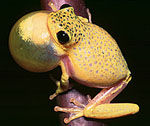What
you've heard is true: It's not easy being green. Frogs face a formidable
number of predators, yet their defenses are few. For most frogs, the
best defense is to stay hidden. But when camouflage fails, what's a
frog to do?
Playing dead is a frog favorite; most predators prefer
live prey. Other frogs will try to beat a hasty retreat. Shows of intimidation
can also give predators pause. The tomato frog of Madagascar puffs itself
up like a balloon, making itself appear too big to swallow.
For some frogs, the ace up
the sleeve is poison. All frogs have poison glands in their skin. In
most cases, these toxins aren't strong enough to discourage predators.
(Witness the fact that frogs are a basic food for many animals, including
birds, rodents, fish, foxes, and wolves--and people!) But certain frogs
in Central and South America have especially strong poisons in their
skin. These frogs are called poison dart frogs, because native people
used the poison from their skins on the tips of hunting arrows and blowdarts.
There are about 170 different kinds of poison dart frogs. The most poisonous
is the golden poison frog, each of which contains enough poison to kill
eight people.
Frogs make their calls with
the help of one or two pouches of skin called vocal sacs. Sound is produced
when air rushes over the vocal chords on its way from the lungs into
the vocal sacs. The vocal sacs work like echo chambers to amplify the
sound. Some frog calls are so loud, they can be heard up to a mile away.
|
|||||||||||||
|
|||||||||||||
© 1999, The Exploratorium |


